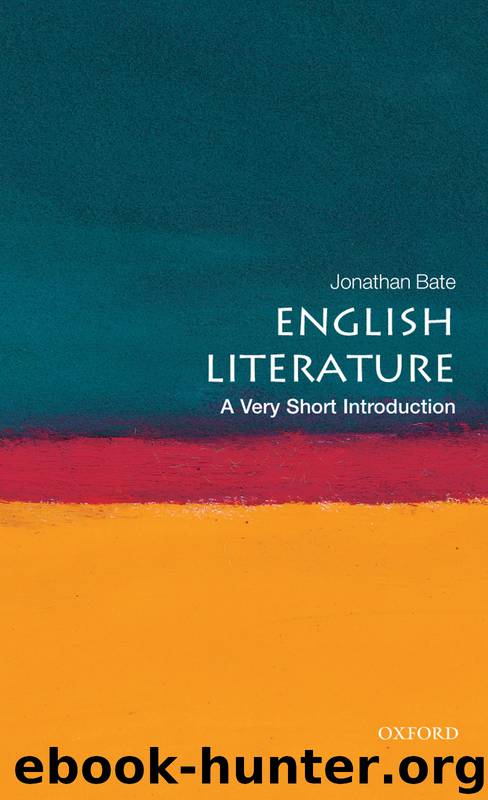English Literature: A Very Short Introduction by Jonathan Bate

Author:Jonathan Bate
Language: eng
Format: epub
Publisher: OUP Oxford
Published: 2010-10-18T16:00:00+00:00
Renaissance
Humanist scholars of the 16th century argued that their age was witnessing new light and rebirth after a long period of cultural darkness. The vocabulary associated with this idea proposed a tripartite division between the enlightened ‘ancients’ of Greece and Rome, the benighted ‘Middle Ages’, and the ‘moderns’ in whom the values of the ancients were reborn. The idea goes back to Petrarch in 14th-century Italy, but it was only in the 19th century that our familiar nomenclature was found for the latter two divisions. After the decline of classical Rome came the medieval (‘middle era’) period. Thus John Ruskin in the fourth of his 1854 lectures on architecture: ‘You have, then, the three periods: Classicalism, extending to the fall of the Roman empire; Mediaevalism, extending from that fall to the close of the fifteenth century; and Modernism.’ Ruskin’s assertion that, in northern Europe at least, the modern era began at the close of the 15th century was widespread, but the term favoured above modernism was Renaissance, a word which was first used in France by Jules Michelet, which reached England in the 1840s, which Matthew Arnold in Culture and Anarchy (1869) attempted to Anglicize as ‘Renascence’, and which achieved wide currency through Jacob Burckhardt’s The Civilization of the Renaissance in Italy (1860) and Walter Pater’s The Renaissance (1873). Pater made clear that the word referred not merely to the re-birth – from French renaître – of the ancients, but to ‘a whole complex movement of which that revival of classical antiquity was but one element or symptom’. The 19th-century understanding of this movement may be summed up in a phrase that Burckhardt borrowed from Michelet: the discovery of the world and the discovery of man.
The English have traditionally been regarded as having far greater distinction in literature and theatre than in painting, sculpture, and music. Burckhardt’s civilization of the Renaissance in Italy was embodied in the visual arts – Michelangelo, Raphael, Donatello, Piero della Francesca. The English Renaissance, by contrast, was associated with the poets and playwrights of the reign of Queen Elizabeth I (1558–1603). This meant that whereas the art of the Italian Renaissance was closely associated with Roman Catholicism, the literature of the English Renaissance emerged out of an aggressively Protestant environment. In the Art of English Poesy (1589), written in the immediate wake of the defeat of the Spanish Armada, George Puttenham located the origins of the Elizabethan literary efflorescence in the precise period when the religious Reformation began in England:
In the latter end of [Henry VIII]’s reign sprang up a new company of courtly makers, of whom Sir Thomas Wyatt the elder and Henry Earl of Surrey were the two chieftains, who having travelled into Italy, and there tasted the sweet and stately measures and style of the Italian Poesy, as novices crept out of the schools of Dante, Ariosto, and Petrarch, they greatly polished our rude and homely manner of vulgar Poesy from that it had been before, and for that cause may justly be said the first reformers of our English metre and style.
Download
This site does not store any files on its server. We only index and link to content provided by other sites. Please contact the content providers to delete copyright contents if any and email us, we'll remove relevant links or contents immediately.
| African | Asian |
| Australian & Oceanian | Canadian |
| Caribbean & Latin American | European |
| Jewish | Middle Eastern |
| Russian | United States |
4 3 2 1: A Novel by Paul Auster(11032)
The handmaid's tale by Margaret Atwood(6836)
Giovanni's Room by James Baldwin(5870)
Big Magic: Creative Living Beyond Fear by Elizabeth Gilbert(4717)
Asking the Right Questions: A Guide to Critical Thinking by M. Neil Browne & Stuart M. Keeley(4564)
On Writing A Memoir of the Craft by Stephen King(4205)
Ego Is the Enemy by Ryan Holiday(3982)
Ken Follett - World without end by Ken Follett(3968)
The Body: A Guide for Occupants by Bill Bryson(3789)
Bluets by Maggie Nelson(3705)
Adulting by Kelly Williams Brown(3663)
Guilty Pleasures by Laurell K Hamilton(3578)
Eat That Frog! by Brian Tracy(3505)
White Noise - A Novel by Don DeLillo(3430)
The Poetry of Pablo Neruda by Pablo Neruda(3358)
Alive: The Story of the Andes Survivors by Piers Paul Read(3302)
The Bookshop by Penelope Fitzgerald(3220)
The Book of Joy by Dalai Lama(3212)
Fingerprints of the Gods by Graham Hancock(3206)
